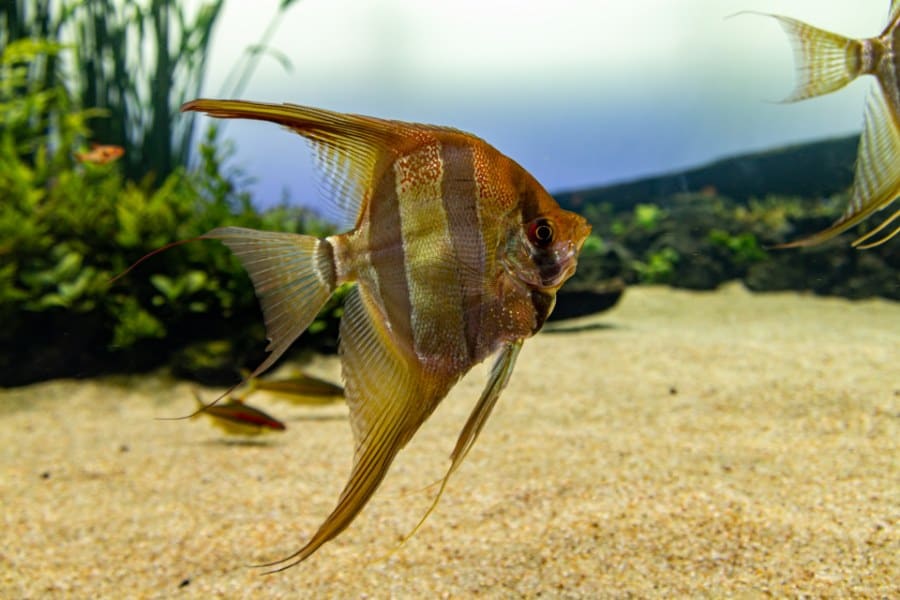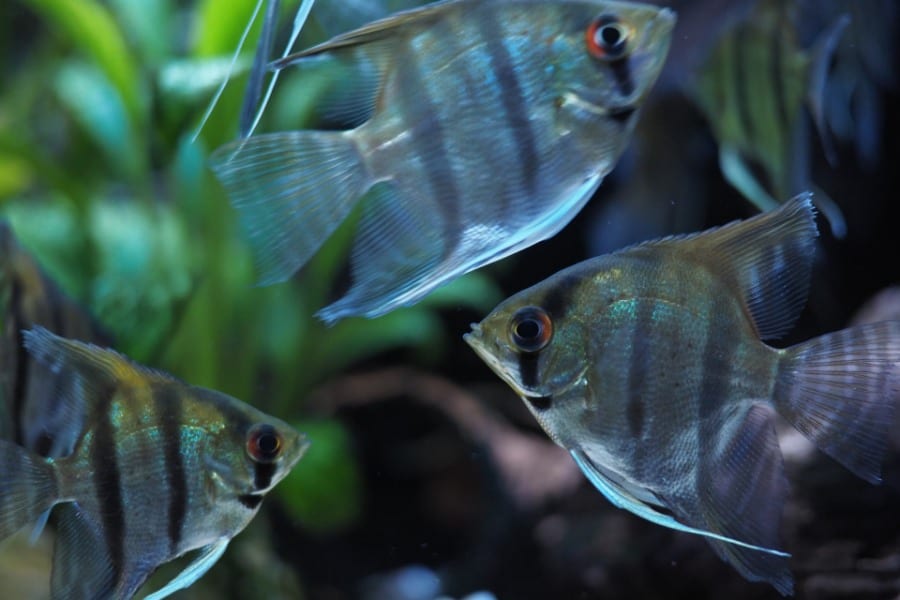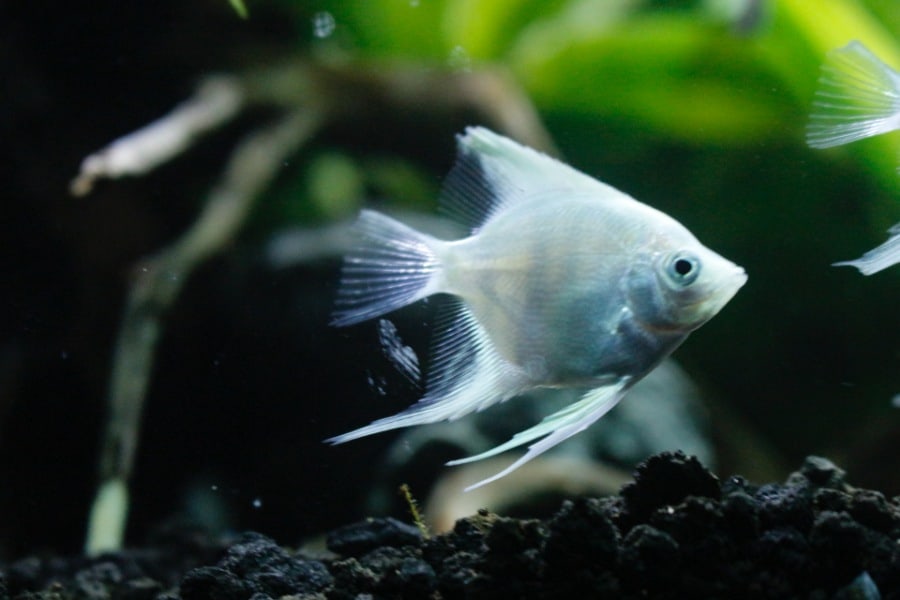Angelfish are a type of freshwater cichlid that is native to South America. These beautiful fish are iconic for their vibrant colors and interesting patterns, which makes it unsurprising that many people want to keep them as pets.
But before you go out and buy one, it’s important to make sure that you have a suitable tank for them.
In this article, we’ll be discussing Angelfish tank size requirements and some of the things you need to consider before setting up an Angelfish tank.
Minimum Tank Size for Angelfish
Before anything else, let’s clear something up first: Angelfish are not beginner fish. They are actually quite difficult to care for, particularly the marine type.
One of the main reasons for this is that they require specific tank requirements, including the minimum tank size.
There are over 90 species of marine and freshwater Angelfish, and they come in a wide variety of shapes and sizes.
This means that there is no one-size-fits-all answer to the question “What is the minimum tank size for Angelfish?”
That being said, a general rule of thumb is that you should have a minimum tank size of at least 20 gallons for one pair.
Of course, the bigger the better. Keep in mind that these fish are social creatures and do best in groups. So, if you have the space, we recommend getting a larger tank so that you can accommodate more of them.
Factors to Consider When Choosing Angelfish Tank Size
Although 20 gallons is the bare minimum, there are actually a few other factors that you need to consider when choosing an Angelfish tank size.
Some of the things you need to take into account include the following.
Type of Angelfish
As mentioned earlier, there are over 90 species of Angelfish. Only 3 of these are of the freshwater variety. These are the common Angelfish, the Leopold’s, and the Altum.
Depending on the type of Angelfish you have, the minimum tank size may differ. For instance, many marine species, like the Emperor Angelfish, the Queen Angelfish, and the French Angelfish typically need a larger tank than freshwater species since they grow to be bigger.
Temperament
Some Angelfish species are more aggressive than others. Examples include the Bicolor Angelfish, the Keyhole Angelfish, and the notorious Lemonpeel Angelfish.
These fishes need more space since they are more likely to attack and chase other Angelfishes when they’re stressed. With enough space, however, they can still be kept in a group.
On the other hand, there are Angelfish species that are more peaceful and can do well even in community tanks with other fish.
Number of Angelfish
Of course, the number of Angelfish you have will also affect the tank size. Going by our recommended minimum size, you should start off with 20 gallons for one pair, and then add 10-30 gallons per additional individual, depending on their size and type.
If you want a whole group of these fish, it’s always best to err on the side of caution and get a larger tank. This will not only give your fish more space to move around, but it will also help reduce aggression and stress levels.
Size of Angelfish
Marine species like the Emperor Angelfish, for example, can grow up to 18 inches in length. On the other hand, dwarf species like the Coral Beauty Angelfish only grow to be about 3-4 inches long.
Of course, the bigger the Angelfish, the more space it needs to grow. So, if you’re planning on getting a larger species, make sure that you have a tank that can accommodate their full size.
Tankmates
If you’re planning to add tankmates to your Angelfish tank, you need to make sure that they can fit in your chosen tank size as well.
For instance, if you’re putting a pair of Angelfish with a few Platies, a 20-gallon tank probably won’t be enough. You have to account for both species’ adult sizes as well as their swimming space needs.
Plants
Although they technically don’t need them, Angelfish enjoy densely planted tanks. Females lay their eggs on plants, so it can help them feel calmer.
Additionally, plants can give Angelfishes their much-needed hiding places when they feel stressed or threatened.
If you’re not comfortable with live plants, you can always put fake plants in your tank. Silk plants are preferable because they’re soft and won’t hurt your Angelfish’s fins.
If you think you can handle live plants, though, we highly recommend them. In addition to the benefits listed above, live plants can also help oxygenate the tank and remove toxins from the water.
Some of the best plants for Angelfish tanks include Anubias, Java Ferns, Amazon Swords, and Hornwort. Keep in mind that you’ll need to give your plants enough space to grow, which means that you’ll need a bigger tank.
Decorations
Like plants, Angelfishes also benefit from having tank decorations. Hiding places are essential for these fishes since they can be quite aggressive, even towards each other.
The most popular decorations for Angelfish tanks include driftwood, rocks, and caves.
However, you have to make sure that there are still plenty of open swimming areas in your tank, which means you should opt for a larger tank if you have lots of decorations. These fish are known to be good swimmers, so they need space to move around.
Ideal Tank Size for Full Grown Angelfish
We now know the various factors that affect Angelfish tank size, so let’s put it all together and find out the ideal tank size for full-grown individuals.
As previously mentioned, the ideal tank size varies depending on what exact species you have. Some species need a tank size of at least 150 gallons, while others can thrive in a tank as small as 40 gallons.
In short, when selecting an aquarium size, be sure to consider the needs of your specific species.
Here’s a table of 20 of the most common species, how big these Angelfishes get, and their ideal tank size.
| Species | Adult Size | Ideal Tank Size for 1 Pair |
| Common Angelfish | 6 inches | 70 gallons |
| Leopold Angelfish | 3 inches | 40 gallons |
| Altum Angelfish | 15 inches | 150 gallons |
| Queen Angelfish | 20 inches | 250 gallons |
| Coral beauty Angelfish | 4 inches | 70 gallons |
| Emperor Angelfish | 16 inches | 220 gallons |
| Flame Angelfish | 4 inches | 70 gallons |
| Potter’s Angelfish | 5 inches | 70 gallons |
| Koi Angelfish | 6 inches | 80 gallons |
| Dwarf Angelfish | 4 inches | 70 gallons |
| Black Nox Angelfish | 4 inches | 70 gallons |
| Regal Angelfish | 10 inches | 125 gallons |
| Gold Flake Angelfish | 10 inches | 125 gallons |
| French Angelfish | 15 inches | 220 gallons |
| Koran Angelfish | 15 inches | 220 gallons |
| Pygmy Cherub Angelfish | 3 inches | 70 gallons |
| King Angelfish | 14 inches | 220 gallons |
| Bicolor Angelfish | 6 inches | 80 gallons |
| Bandit Angelfish | 7 inches | 80 gallons |
| Lemonpeel Angelfish | 6 inches | 80 gallons |
How Fast Do Angelfish Grow?
If you’re getting your Angelfish as a juvenile, you may be fooled into thinking that you don’t need a very large tank.
However, Angelfish can grow quite quickly, so it’s important to factor in their growth rate when choosing a tank size.
On average, juvenile Angelfish continue growing until they become sexually mature. The exact timeline differs per species, but they typically reach the age of sexual maturity by the time they’re 8-12 months old. Their size at this time should be their full adult size.
Of course, each individual Angelfish is unique and may not grow at the same rate as others. Some Angelfish grow faster than others, while others may grow slower.
Here are some factors that can affect the speed of their growth.
- Species: Some species grow faster than others. For instance, Dwarf Angelfish grow relatively slowly while Koi Angelfish can grow quite quickly.
- Water conditions: A healthy environment is critical in ensuring the growth of these fish. This means changing the tank water regularly, checking the tank water’s ammonia and nitrogen levels, and making sure the water is well-filtered and oxygenated.
- Food: A nutritious diet is also necessary for Angelfish growth. They should be fed a variety of foods, including live food, frozen food, pellet food, and so on. Without this, their growth may be stunted.
Knowing how quickly Angelfish can grow, you should factor in their growth rate when choosing a tank size. That 2-inch pair of Angelfish you’re housing in your 10-gallon can become 8 inches in just a few months – which means they’re no longer suitable for that tank.
A tank that’s too small can stunt your fish’s growth, severely impact their health, and even shorten their lifespan.
To be on the safe side, always choose a tank size that’s big enough for your Angelfish to reach their full size. This way, you won’t have to upgrade to a bigger tank later on.
Related:
- How Often Do Angelfish Lay Eggs?
- Can Angelfish Live with Goldfish: Why Separate Them?
- Goldfish Tank Size
FAQs
What Size Tank Do I Need for 2 Angelfish?
A pair of Angelfishes need at least a 20-gallon tank, at the very minimum. However, this doesn’t apply to all species. For instance, a pair of fully grown Emperor Angelfishes won’t fit in a 20-gallon because each fish measures 16 inches.
Is a 10-Gallon Tank Big Enough for An Angelfish?
A 10-gallon tank is certainly not big enough for a fully grown Angelfish. You may be able to put a pair of babies or juveniles in there, but they’ll outgrow the tank quickly in just a span of a few months.
How Big of A Tank Do I Need for 4 Angelfish?
The size of the tank you need for 4 Angelfish depends on the size of the fish themselves. For smaller species like the Dwarf Angelfish, you can get by with as little as 70 gallons, ideally more.
Conclusion
In conclusion, the ideal tank size for Angelfish really depends on how many fish you want to keep. A pair of small Angelfish species needs at least a 20-gallon tank, but adding more individuals or keeping large species will require a bigger tank.
When in doubt, always choose a tank size that’s big enough for your Angelfish to reach their full size. Not only will your Angelfish thrive, but they’ll be happier and healthier as well.


